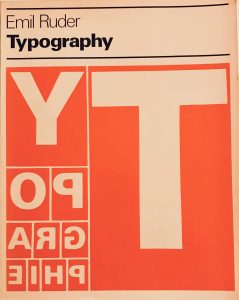International Typographic Style first emerged in the 1920’s and was an era of graphic design also known as ‘Swiss Style’ which later fully developed in the 1950’s by designers in Switzerland. This style was part of the modernist movement of the time, the want to represent information objectively, without associated meaning and this had a profound impact on graphic design and design related fields like architecture and art. Main characteristics of the Swiss Style would be asymmetrical layouts, grid systems, sans-serif typefaces, simple and clean designs with left aligned text. Early examples of International Typographic Style feature typography as the main design element and favour photography over illustrations. After the Second World War when international trade became more prevalent, the Swiss Style began to expand further beyond Switzerland to America where it would continue to develop.
The Basel School of Design had an early influence on the development of the International Typographic Style as they had a course that used a graphic design technique using grid work in the early 1900’s. These grid work systems allowed for consistent output that was hierarchically structured as well as highly legible. 18 years later, a professor at the Zurich University of the Arts, Ernst Keller developed a typography and graphic design course whereby he taught his students a philosophy that dictated “beauty for the sake of beauty“ or “the creation of beauty as a purpose in and of itself“. His works are composted of bright colours and geometric forms.


During the 1950’s, the International Typographic Style begun to become synonymous with sans-serif fonts for their clean simplistic look and many pieces from this time feature fonts such as Univers which paved the way for the Neue Hass Gortoesk typeface, later named Helvetica which is considered to be the most widely used fonts to exist. Max Miedinger designed the Swiss font in 1957, alongside Edouard Hoffmann, to follow the same principles of the Swiss Style, to be a neutral typeface with no particular reference behind it, minimalist aesthetic and easily readable. This is highlighted by Massimo Vignelli, an Italian designer, in the Helvetica documentary, “Helvetica is a typeface that is generated from a desire to have better legibility”. Today the font can be found on social medias like Facebook and Instagram and its ability to be read in motion is the reason why it can be found used by airlines.


Josef Müller-Brockmann was a pioneer of the International Typographic Style and is recognised for his clean and simple designs, use of sans-serif typography, colours and shapes that went on to inspire many graphic designers a century later. Many of works show the influences from previous movements such as De Stijl, Constructivism and ideals established at the Bauhaus. Müller-Brockmann went on to replace his previous professor, Ernst Keller, as professor of graphic design and was later appointed as European design consultant for International Business Machines in America due to the well respected role he had developed within the design community.



Another influential designers was Emil Ruder who was a graphic designer and typographer who taught at the Basel School of Design and set a new standard for typography in a book he published titled ‘Typography: A Manual of Design. The Swiss Style was prevalent throughout his book and this taught the next generation of typographers and designers these new set of guidelines of grid systems and the importance of typography being use to communicate ideas. Many of his works show his preferred use of asymmetrical compositions and negative space.



Sources
https://en.wikipedia.org/wiki/Josef_Müller-Brockmann
https://www.idesign.wiki/en/tag/ernst-keller/#google_vignette
https://en.wikipedia.org/wiki/International_Typographic_Style
https://www.idesign.wiki/en/category/styles-and-movements/page/2/
Comments